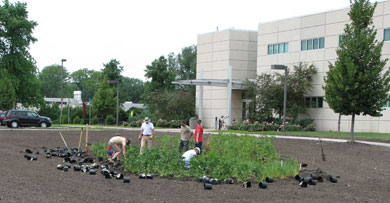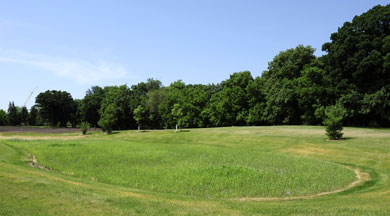Inside Iowa State
Inside ArchivesSubmit newsSend news for Inside to inside@iastate.edu, or call (515) 294-7065. See publication dates, deadlines. About InsideInside Iowa State, a newspaper for faculty and staff, is published by the Office of University Relations. |
July 3, 2008 
Native plants were added July 2 to a new bioretention area created southeast of the Administrative Services Building (intersection of Daley Drive and Stange Road). Photo by Erin Rosacker. Recycling the rainby Erin Rosacker Does the term "rain garden" summon an image of weed-choked standing water swarming with mosquitoes? Instead, picture an area filled with Iowa's native prairie plants and flowers -- a dry space, except for a few hours following a rainfall. Rain gardens are among the tools Iowa State planners incorporate the campus landscape to channel rain into the ground, rather than send it as runoff into streams. For several years, Facilities Planning and Management staff have been implementing a variety of strategies to reduce storm water runoff using sustainable or low-impact methods. "The overall goal is to minimize the rate and volume of water and improve the quality of water that we are sending to the storm water sewer system," said Angie Solberg, landscape architect for FP&M. "We're trying to infiltrate the storm water, capture pollutants and reduce the water temperature before it hits the storm sewer system, which discharges into the local rivers and streams." 
This infiltration basin is located west of Carver Co-Lab. It collects runoff from the site, as well as parking lot 12 (east side of Communications Building. Photo by Bob Elbert. The ingredientsNative Iowa plants are an important component to controlling runoff because they have deep root systems that draw water into the ground. "Turf is good, but the root structures of native grasses are a lot deeper," said Solberg. These roots -- six feet and deeper -- also can draw water up to sustain the plants during dry periods. They require no fertilizer, naturally crowd out weeds, keep the soil porous and attract wildlife, such as butterflies and birds. Soil types determine the type of storm water management best suited for different areas. Rain gardens use loamy, spongy soil layers to filter water into the ground naturally. Bioswales and bioretention cells, which use rock and drain tile to help percolate the water into the ground, sometimes are necessary for areas with compacted or clay soils. Problem areas can start with roof and parking lot runoff. "Parking lots, streets and roofs are big, impermeable spaces. You want to capture the water and get it into the ground before it gets off site," Solberg said. Looking aheadMany storm water management projects are on the docket for FP&M, especially at construction and major renovation sites. Solberg said plans and costs for storm water management are factored into those projects. "There are 11 storm water management projects currently proposed or under construction, with multiple low-impact development ideas that are being designed and implemented." Solberg said. "We're going above and beyond as much as we can." The new chemistry facility (Hach Hall) and Biorenewables Research Laboratory have "gray water" systems planned. Storm water will be captured in cisterns and used as a non-potable water resource for things such as flushing toilets. The College of Design addition includes rain gardens, native plants, a green roof and permeable paving that allows water to filter through -- rather than run off -- the pavement. Native plants and rain gardens also are a part of the Biorenewables Research Lab, Alumni Center and Dr. W. Eugene and Linda Lloyd Veterinary Medical Center projects. "We're trying to infiltrate and reuse storm water instead of just detaining it or piping it to the creeks," Solberg said. "We can accomplish this by using low-impact strategies, including green roofs on buildings, porous pavement, native plants, rain gardens and cisterns for collection for gray water. These strategies are an important part of the LEED certification process as well. The more you can use or reuse the rain water, the better off you are." |

A bioswale with native plants is located on a strip of land between parking lot 35 and Winlock Road. The plants, which will fill in over the years, have deep root systems that pull water into the ground. Photo by Bob Elbert. Quote"We're trying to infiltrate the storm water, capture pollutants and reduce the water temperature before it hits the storm sewer system, which discharges into the local rivers and streams." Angie Solberg, FP&M landscape architect |